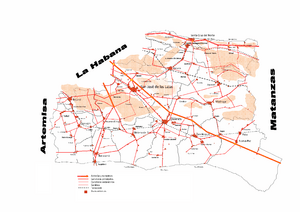Mayabeque Province facts for kids
Quick facts for kids
Mayabeque Province
|
||
|---|---|---|
|
||
 |
||
| Country | Cuba | |
| Capital | San José de las Lajas | |
| Municipalities | San José de las Lajas, Jaruco, Santa Cruz del Norte, Madruga, Nueva Paz, Güines, Melena del Sur, Quivicán, Batabanó, San Nicolás de Bari, Bejucal | |
| Area | ||
| • Total | 3,732.73 km2 (1,441.22 sq mi) | |
| Population
(2010-12-31)
|
||
| • Total | 381,385 | |
| • Density | 102.17321/km2 (264.6274/sq mi) | |
| Time zone | UTC-5 (EST) | |
| Area code(s) | +53-47 | |
| HDI (2019) | 0.797 high · 3rd of 16 |
|
| Website | https://www.mayaweb.gob.cu/es/ | |
Mayabeque Province is one of Cuba's newer provinces. It was created on January 1, 2011. Before that, it was part of the old La Habana Province. Mayabeque is located in the western part of Cuba. Its capital city is San José de las Lajas.
Discover Mayabeque Province
Mayabeque Province was formed from the eastern part of the former La Habana Province. This change was approved by the Cuban National Assembly in 2010. The new province officially began on January 1, 2011. Another new province, Artemisa Province, was also created at the same time.
The province gets its name from the Mayabeque River. This is the biggest river in the area. The name also comes from Mayabeque beach. Many people believe this beach was the original spot where the city of Havana was founded in 1514.
Mayabeque is one of the smaller provinces in Cuba. It is also one of the least populated, not counting Havana city itself.
Economy and Industries
Mayabeque's economy is mostly based on farming. Farmers grow many crops like potatoes, fruits, vegetables, and sugar cane. Raising animals, especially for milk, is also very important here.
The province also has a strong industry sector. Many factories are found in San José de las Lajas and Santa Cruz del Norte. These factories make building materials, electrical cables, and rubber products. They also produce glass containers, ceramics, and processed foods.
Other important industries include paper processing and bio-pharmaceuticals, which are made in Bejucal. Fishing products are also a part of the economy. The province has oil and gas extraction sites too.
Mayabeque is home to two large factories that make Havana Club rum. There are also power plants and sugar mills. The province has important scientific research centers. It also has a university focused on agricultural science.
Exploring Mayabeque's Towns
Mayabeque Province is made up of 11 different municipalities, which are like towns or districts. Each municipality has its own unique features. The capital city is San José de las Lajas.
Here is a list of the municipalities in Mayabeque Province:
| Municipality | Area (km2) | Population | People per km2 |
|---|---|---|---|
| Bejucal | 116.36 | 26,966 | 231.7 |
| San José de las Lajas | 592.67 | 74,186 | 125.2 |
| Jaruco | 275.9 | 25,135 | 91.1 |
| Santa Cruz del Norte | 379.38 | 34,216 | 90.2 |
| Madruga | 459.58 | 29,805 | 64.9 |
| Nueva Paz | 522.8 | 25,471 | 48.7 |
| San Nicolás | 228.86 | 20,695 | 90.4 |
| Güines | 433.09 | 67,919 | 156.8 |
| Melena del Sur | 233.56 | 20,646 | 88.4 |
| Batabanó | 263.43 | 26,944 | 102.3 |
| Quivicán | 227.1 | 29,463 | 129.7 |
| Total | 3,732.73 | 381,446 | 102.2 |
Source: Oficina Nacional de Estadísticas e Instituto de Planificación Física/2010
The most populated cities in Mayabeque are Güines, with about 42,000 people, and San José de las Lajas, with about 37,000 people.
See also
 In Spanish: Provincia de Mayabeque para niños
In Spanish: Provincia de Mayabeque para niños




